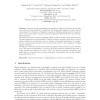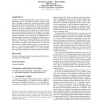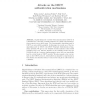25 search results - page 4 / 5 » Breaking a Cryptographic Protocol with Pseudoprimes |
117
click to vote
JCS
2011
14 years 6 months ago
2011
We explore a new direction towards solving the identity authentication problem in RFID systems. We break the RFID authentication process into two main problems: message authenticat...
CCS
2006
ACM
15 years 3 months ago
2006
ACM
Consider a pollster who wishes to collect private, sensitive data from a number of distrustful individuals. How might the pollster convince the respondents that it is trustworthy?...
127
click to vote
CRYPTO
2011
Springer
13 years 11 months ago
2011
Springer
Structure-preserving signatures are signatures defined over bilinear groups that rely on generic group operations. In particular, the messages and signatures consist of group elem...
105
click to vote
PODC
2004
ACM
15 years 5 months ago
2004
ACM
Group key exchange protocols allow a group of servers communicating over an asynchronous network of point-to-point links to establish a common key, such that an adversary which fu...
82
Voted
CTRSA
2009
Springer
15 years 6 months ago
2009
Springer
Digital Enhanced Cordless Telecommunications (DECT) is a standard for connecting cordless telephones to a fixed telecommunications network over a short range. The cryptographic al...



